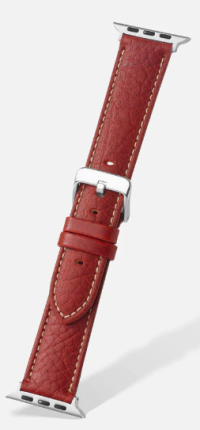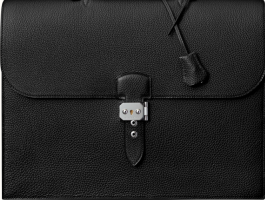This has always confused me, because if it was a bag used for horse grooming, and the brushes and stuff were wet, why hold the perforations next to your body and not out facing the street?The Evelyne is meant to be used with the perforated “H” facing the body
You are using an out of date browser. It may not display this or other websites correctly.
You should upgrade or use an alternative browser.
You should upgrade or use an alternative browser.
Share interesting Hermès facts here!
- Thread starter needmoneyforbirkins
- Start date
More options
Who Replied?This book is on it’s way to me. It sounds like a fun read!  Thanks to @Amka for posting it on the Web Hermès Finds thread.
Thanks to @Amka for posting it on the Web Hermès Finds thread.

 Thanks to @Amka for posting it on the Web Hermès Finds thread.
Thanks to @Amka for posting it on the Web Hermès Finds thread. 
Just found out today..by chance. I was using the wand (ultraviolet sanitizer) and when it passed thru the orange boxes (most of it not all though) of H, I noticed that you can see that there are actually the brand's logos (horse, carriage, and equestrian) all over when illuminated by the wand. Very cool!
This has always confused me, because if it was a bag used for horse grooming, and the brushes and stuff were wet, why hold the perforations next to your body and not out facing the street?
I wear my Evelynes with the perforations facing me, but I don’t care what the ‘right’ way is, I don’t like logos.
Most horse grooming stuff won’t be dripping wet though. If your horse is somehow extra muddy or likes to roll around in water (like mine…), you are likely rinsing and drying those brushes and other grooming tools before putting them away. So they are only a little wet at most. Having said that, I wouldn’t use an Evelyne for grooming… we have a caddy with all the grooming tools, and that gets used.
I love her dedication!!I told my daughter about this and she found 46 of them on this bag before stopping. I can barely even see them in her circles.
View attachment 5579145
I love her dedication!!
She only stopped because she said it was making her eyes tired.

Interesting. I’ve worn the Evelyne PM both ways and prefer to wear it with H perforations facing in. I find I can access the small pocket easier this way (phone, mask, etc)I wear my Evelynes with the perforations facing me, but I don’t care what the ‘right’ way is, I don’t like logos.
Most horse grooming stuff won’t be dripping wet though. If your horse is somehow extra muddy or likes to roll around in water (like mine…), you are likely rinsing and drying those brushes and other grooming tools before putting them away. So they are only a little wet at most. Having said that, I wouldn’t use an Evelyne for grooming… we have a caddy with all the grooming tools, and that gets used.
I don't know, though:Togo and Clemence are embossed leathers. The grains that you see are not natural.
Here from Hermès com UK:
Find out more about Togo calfskin
This leather, the result of an intensive drumming process that brings out its natural features, owes its name to the theme of the year of its creation: Africa. It is named after an African country.
First appeared in the collections: 1997
Appearance: Matt; round and irregular grain; veins and wrinkles often visible and very pronounced
Feel: Dry; quite responsive; well-rounded
Hand: Supple and responsive
Change over time: Softens
vs: Epsom
Find out more about Epsom calfskin
This printed leather takes its name from a town in south-east England that is famous for its horse races. Its fine, regular grain, obtained through machine-printing, has a striking, beautifully subtle dual tone.
First appeared in the collections: 2004
Appearance: Small, regular and slightly glossy grain; uniform; deep colors
Feel: Dry, with a slightly "up and down" grain
Hand: Round and firm
Change over time: Keeps its shape, scratch-resistant. The grain fades in areas exposed to a lot of contact or rubbing
The “intensive drumming process” you mention doesn’t give the togo leather the pebble grains. It’s the pressing with heat that produces the pattern.I don't know, though:
Here from Hermès com UK:
Find out more about Togo calfskin
This leather, the result of an intensive drumming process that brings out its natural features, owes its name to the theme of the year of its creation: Africa. It is named after an African country.
First appeared in the collections: 1997
Appearance: Matt; round and irregular grain; veins and wrinkles often visible and very pronounced
Feel: Dry; quite responsive; well-rounded
Hand: Supple and responsive
Change over time: Softens
vs: Epsom
Find out more about Epsom calfskin
This printed leather takes its name from a town in south-east England that is famous for its horse races. Its fine, regular grain, obtained through machine-printing, has a striking, beautifully subtle dual tone.
First appeared in the collections: 2004
Appearance: Small, regular and slightly glossy grain; uniform; deep colors
Feel: Dry, with a slightly "up and down" grain
Hand: Round and firm
Change over time: Keeps its shape, scratch-resistant. The grain fades in areas exposed to a lot of contact or rubbing
If you see how drums work in leather tanning, the leather that comes out of them are always smooth. And sometimes still very much wet.
Some people would say, “but there are veins in togo. Certainly the embossing would’ve erased that”. Yes, it’s there because unlike epsom, togo is not “flattened” with the embossing. (Also epsom not only an embossed leather, it is a laminated leather, which hides a lot of imperfections and gives it that plasticky feel.) So whatever mark is there, like veins, they will still show because the embossing just added more patterns to the surface of the leather.
Cowhide leather always comes out smooth, no matter how it is treated. The only way they get grains is when machines press on them.
Which makes Barenia Faubourg an embossed leather as well.
Last edited:
The “intensive drumming process” you mention doesn’t give the togo leather the pebble grains. It’s the pressing with heat that produces the pattern.
If you see how drums work in leather tanning, the leather that comes out of them are always smooth. And sometimes still very much wet.
Some people would say, “but there are veins in togo. Certainly the embossing would’ve erased that”. Yes, it’s there because unlike epsom, togo is not “flattened” with the embossing. (Also epsom not only an embossed leather, it is a laminated leather, which hides a lot of imperfections and gives it that plasticky feel.) So whatever mark is there, like veins, they will still show because the embossing just added more patterns to the surface of the leather.
Cowhide leather always comes out smooth, no matter how it is treated. The only way they get grains is when machines press on them.
Which makes Barenia Faubourg an embossed leather as well.
There's just so much wrong with this. Grains are very much a natural part of the skin. Pebble grains can be natural or embossed, but there's no indication that Togo is embossed. Drums can be used in several steps of the tanning process, and tumbling a finished leather dry in a drum with high heat will bring out those natural grains and result in pebble or shrunken leather.
So many things wrong with your statements as well.There's just so much wrong with this. Grains are very much a natural part of the skin. Pebble grains can be natural or embossed, but there's no indication that Togo is embossed. Drums can be used in several steps of the tanning process, and tumbling a finished leather dry in a drum with high heat will bring out those natural grains and result in pebble or shrunken leather.
Shrunken leather is different from pebble leather. Shrunken leather looks like this:

You can see with Togo that it's embossed by the uniformity of the pebbling. You cannot achieve that uniformity by letting the leather shrink by itself and have no control.
Natural pebble grain leather means that the leather is natural (meaning not faux) but the pebble pattern is still embossed, as you can read from here:

Pebbled Leather - Texture with Style and Durability
The surface of texture leather can add a lot to how it looks and how it performs. Pebbled leather looks great and performs well.
 www.libertyleathergoods.com
www.libertyleathergoods.com
Some more readings for the curious:
What is Pebbled Leather?
Find out how pebbled leather is made, as well as the characteristics and uses of pebbled leather.
Last edited:
If Togo is embossed, why is there such a variation in the size of the grains? Epsom is admittedly embossed and all looks very uniform. My Togo items on the other hand all look wildly different both in size and with no repeatable patterns.So many things wrong with your statements as well.
Shrunken leather is different from pebble leather. Shrunken leather looks like this:
View attachment 5580417
You can see with Togo that it's embossed by the uniformity of the pebbling. You cannot achieve that uniformity by letting the leather shrink by itself and have no control.
Natural pebble grain leather means that the leather is natural (meaning not faux) but the pebble pattern is still embossed, as you can read from here:

Pebbled Leather - Texture with Style and Durability
The surface of texture leather can add a lot to how it looks and how it performs. Pebbled leather looks great and performs well.www.libertyleathergoods.com
Some more readings for the curious:
What is Pebbled Leather?
Find out how pebbled leather is made, as well as the characteristics and uses of pebbled leather.www.carlfriedrik.com
I have mentioned this in the previous pages but if you look at a certain angle, you can see that there is a sort of a grid pattern on on this togo:If Togo is embossed, why is there such a variation in the size of the grains? Epsom is admittedly embossed and all looks very uniform. My Togo items on the other hand all look wildly different both in size and with no repeatable patterns.

On the other hand, the article I mentioned says:
"Once dyed, the leather is now run through machines that have large, metal plates. The plates are etched in reverse with the pebble pattern. This is so when they pass the pattern into a material, it will look as desired. Think of this like the dies used to make coins, they’re cut in reverse, so when they strike the metal, a properly-oriented coin surface comes out.
The pebbled pattern is a textured, rounded, random design. The plates, with tremendous force, are then pressed into the leather, leaving its permanent shape in the material."
So it's also possible that the plates that the tannery is using for pressing the leathers are randomized itself, i.e. without the grid pattern that can be seen above.
Togo is a pebble-grained leather, and by definition, all pebble-grained leathers are pressed to get the grains.
Register on TPF! This sidebar then disappears and there are less ads!


